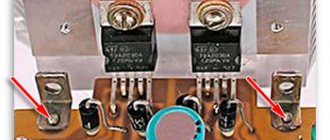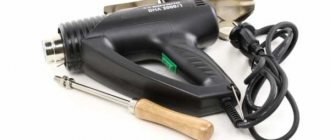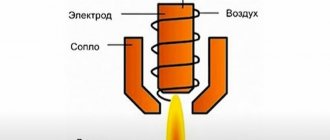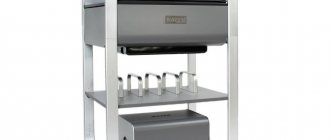Due to the improvement of assembly technologies for various types of products assembled from small metal parts (electronic microcircuits), their manual soldering is causing more and more difficulties.
A homemade soldering gun will allow the operator to cope with the difficulties that arise in these situations without any special complications and eliminate the risks that arise.
So, with the help of a self-assembled soldering station, anyone can install and dismantle parts without the threat of damaging fragile electronic elements located near the soldering site. One of the possible solutions to this problem allows you to make a hot air gun from a soldering iron, which is available in the household kit of any home craftsman.
Prologue
In the past, for all sorts of “thermal technologies” (of course, except for soldering and dismantling radio components), I used a small lighter with a nozzle. But a gas burner, in terms of producing a hot stream of air, has a number of disadvantages. With its help, it is impossible to smoothly regulate the temperature, the size of the torch depends on the amount of gas in the tank, an open flame can cause a fire, and finally, you need to buy gas in cans.
So, it was decided to make a small hairdryer from all sorts of rubbish that can be found in the bins of a DIYer. An additional incentive to produce this device was the price of a factory-made hair dryer, which starts at about $30.
I note that during the assembly and testing of the subject, I built another, still speculative, model of a hair dryer with higher power. So, if you need a more serious unit, stay tuned for new publications.
Operating principle of a hot air gun
All devices can be divided into two groups:
- household;
- industrial.
A household hair dryer for soldering plastic is an excellent device with which you can perform many jobs: from installing linoleum to welding PVC.
Some devices are equipped with a temperature controller , which allows you to select the optimal parameters for various materials. The presence of an adjustment mechanism expands the scope of application: you can solder copper pipes with a hairdryer or carry out restoration repairs of microcircuits.
Before work, it is necessary to identify the material of the part, since only polymers from the group of thermoplastics can be heated - after heating they return to their original state without loss of performance characteristics.
The degree of temperature exposure can be adjusted by changing the distance from the nozzle to the surface of the workpiece. This requires certain skills, since if it is removed excessively, the part will not warm up to the required temperature throughout its entire depth, which will negatively affect the parameters of the seam. For example, poor-quality welding of PVC fabric leads to loss of joint tightness.
Main parts and materials
I've had this fan lying around idle for a while now. These 40mm fans used to be widely used in PC 486 and video cards.
This unit will require minimal modification. You will need to re-insert the wire into the attachment point.
I didn’t have a tube of a suitable diameter for the heater air duct, so I borrowed it from a ten-watt resistor type C-5-5. To free the tube from the insides, I sawed off one of its rolled edges with a file.
I do not recommend using ceramics or quartz glass for the heater air duct, as these materials can be destroyed if flux or wash accidentally gets on a heated surface. I’ll tell you a secret, I did my first experiments with a ceramic heater air duct, which collapsed at the first thermal shock. So, it is better to choose steel or, at worst, some non-ferrous metal.
In order not to bother with making a mica frame, I used a wire with a diameter of 1.2 mm from some kind of rheostat. I think a wire with a diameter of 0.5-1.5mm will do. If you choose a thinner wire, it will not be securely fixed in the housing, and if you choose a thicker one, you will have to increase the cross-section of the cable, which will make the latter too rigid.
Mica will be needed to make a gasket that insulates the coil from the heater tube. The fiberglass will serve as thermal insulation between the heater tube and the hair dryer body.
To make it more convenient to work with recalcitrant materials, you need to use “Rubber Glue”, “88H Glue” or “Moment” glue. Mica can be glued to fiberglass or even paper. The fiberglass can simply be glued and dried. As a result, the glue will burn out, but at the assembly stage it will provide indispensable help.
The heater spiral must be wound in such a way that it is inserted into the tube with a gap, which will subsequently have to be filled with a mica gasket. If you can find a tube of suitable diameter, you can insert the end of the wire into the tube and only then wind the spiral. I didn’t have such a tube, so I simply wound the wire around a metal rod, and then screwed the central wire inside the spiral. This technique is shown in the video>>>
I have used these wonderful products many times to solve completely atypical problems. In this case, electrical terminal blocks will transmit current from the cable to the spiral and fix the position of the spiral relative to the front edge of the tube (to prevent the spiral from shorting to the body).
To make the body of the hair dryer, we will use tin obtained from any non-corrugated tin can.
Often the cylindrical surface of the cans is hidden by a label. If you run your fingernail along the side of a jar in a store, you can easily recognize a jar with a smooth side wall.
From the cylinder of a five-gram syringe we will make a hair dryer handle.
A little about the connector
I used COM dad-mom. From somewhere on the boards. I wired it like this: two groups of three contacts each for heating (more than enough for 5 amperes), one for the fan. Then I fixed it with hot glue and insulated it.
Thus, the power supply is stabilized (if it is not operating at maximum voltage), the fan power supply is stabilized, and therefore the outlet air temperature is stabilized.
I'm happy with the design. For amateur purposes it is quite enough. At maximum heating, the metal pipe in the area of the handle heats up quite noticeably, but the hand is quite tolerable. During normal operation, the pipe is simply warm. Those. nothing will melt there. The air flow through the tube does a good job of cooling. And it is advisable to place the air duct like mine, closer to the handle. To prevent backflow of air from the hot zone. The hairdryer was tested by turning off after maximum heating. I was simply deprived of power. Along with a fan. Nothing melted.
For beginners: to start constructions of this kind, you need to get into bins, stashes, etc. and contemplation of previously accumulated wealth. And with a high degree of probability you will find something that can be used quite easily. What I mean is that the design does not have to completely replicate mine. Good luck. 03/05/2017. Trishin A.O. Komsomolsk-on-Amur.
Drawings of a homemade soldering gun
This is an assembly drawing of a soldering gun. I was too lazy to draw isometric projections, but you can see the soldering gun from all sides by watching the video posted at the beginning of the article.
And this drawing shows the attachment point for the electrical terminal block. The M3 screw securing the terminal block is isolated from the tin body using a small piece of cambric (polyvinyl chloride tube) and an M4 fiberglass washer. An M3 fiberglass washer is placed between the screw heads and the nylon handle of the hair dryer. This washer prevents heat transfer from the electrical terminal block to the hair dryer handle through the M3 screw.
A drawing of the body of a miniature soldering gun in A4 format and 300dpi resolution is located under the thumbnail. If you print it on a printer and stick it on a tin from a tin can, then you can easily make the most complex part of this homemade product.
Making a machine for soldering microcircuits
The components of this device do not differ from the devices that were discussed above. Particular attention should be paid to the housing , since it will experience constant temperature loads. The difficulty is that the cost of thermal insulation materials is quite high, so it is best to use an old hair dryer as a base.
The nozzle attachment point is the most critical area that requires careful insulation. Otherwise, the heat will be transferred to other areas of the hair dryer, which will complicate the soldering process.
The temperature regulator is best placed on the handle . This will allow you to change the basic parameter without being distracted from your work. We recommend using elements from old household appliances as a switch.
Small details
Let's look under the fan to see how the coil is connected to the cable. The design turned out to be very repairable. It is enough to unscrew just a few screws to replace the spiral, for example, in order to adjust the resistance of the spiral to the voltage of an existing power source.
I soldered the petals to the heater cable, but it was possible to roll the ends of the conductors into rings and tin them, just like we do when we change a collapsible power plug.
Most of the things I intend to do with a soldering iron require both hands free. Therefore, I made this stand for fixing the hair dryer on the table. A clamp with an open perimeter allows you to securely hold the hair dryer and, if necessary, easily remove it from the stand.
This is how the soldering gun turned out.
Manufacturing recommendations
Without modification, a hair dryer device for drying hair will not bring success in operation, so it is recommended to use only a motor with a fan and a spiral that will be wound taking into account the requirements for a homemade device. Strong heating, together with a decrease in fan rotation and a decrease in the diameter of the nozzle, leads to burnout of the spiral and melting of the plastic case, and also, if the insulation is poor, a short circuit can occur.
By installing an additional power button for the fan, you can speed up the cooling process of the soldering iron. If you turn off the heating element and leave the cooler on, the heated part of the device will be blown through with air, thereby cooling the entire system. For convenience in working with the device, it is recommended to make a stand with a metal base, as well as using magnets. Thanks to the use of a neodymium magnet, the hot air gun will be securely held in the desired position.
Technical data
The hair dryer fan is powered from a 12 Volt DC source.
The heating element of the hair dryer is powered by an alternating current source of 0...12 Volts. With its help, you can change the temperature of the air flow, from room temperature to 600°C.
Mini-hair dryer parameters at temperature limits.
The diameter of the nichrome wire of the heating element spiral is 1.2 mm.
The heater supply voltage is 9 Volts.
The heater current is 11 Amperes.
Heater power - 100 Watt.
Air flow temperature - 600°C.
The time it takes for the hair dryer to reach the selected temperature mode is 1 minute.
I didn’t make a special power supply for my hair dryer, so I have universal sources of different power at my disposal.
If you do not have a suitable power source, then you can adjust the resistance of the spiral to one of the output voltages of the ATX computer power supply or make the simplest power supply from the ballast of a burnt-out CFL (Compact Fluorescent Lamp). For a detailed description of the modification of the power supply based on CFLs, see here>>>
In the picture, a circuit of a switching power supply for a miniature soldering gun, assembled on the basis of a CFL ballast. Additional elements are highlighted in red. Pulse transformer TV2 has two secondary windings. One of them powers the fan, and the other powers the heater coil. To adjust the temperature of the coil, switch S1 is used.
Safety precautions when working
Working with a hot air gun, especially a self-assembled one, requires special attention to operational safety. There are several rules that must be followed:
- Follow fire safety precautions.
- If a temperature regulator is installed, the temperature threshold cannot be changed by sharply turning the regulator.
- Do not touch the heating element or attachments while the device is operating, as this may cause serious burns and other consequences.
- You can change the nozzle only after turning off and cooling the soldering iron.
- Do not allow water or other liquid to come into contact with the device.
When working with the device, it is recommended to ventilate the room to avoid poisoning by vapors.
About the heater temperature and the choice of material for its body
The operating temperature of the nichrome spiral should not exceed 1000°C. The temperature of a hot coil can be approximately determined by its color. The table shows temperatures in degrees Celsius.
| Metal | Temperature °C |
| Aluminum | 660 |
| Duralumin | 650 |
| Brass | 1000 |
| Copper | 1080 |
| Nickel | 1450 |
| Nichrome | 1550 |
| Steel | 1300 |
As you can see, copper, brass or steel are best suited for making the heater body. But, copper and brass quickly oxidize at high temperatures. Therefore, it is better to choose steel or nickel-plated steel.
If you have defective lithium-ion batteries at your disposal, you can make a tube from the body of one of the cans. The housings of the cans of any lithium-ion batteries and lithium-ion batteries are made of stainless steel.
The picture shows a disassembled laptop battery. The diameter of the can body is 16mm, length – 65mm. How to disassemble a laptop battery is described and shown here>>>
And this photo shows a disassembled “EN-EL1” battery from Nikon cameras. Can diameter 14mm, length – 48mm.
Attention!
The contents of lithium-ion battery cans and lithium-ion batteries are extremely toxic! Therefore, cans should be disassembled outdoors, and the extracted products should be sealed in a secure container and taken to a battery recycling point. Such items are usually available in large supermarkets and specialty stores.
Soldering iron for plastic
Trouble may happen to your car on the road. A small collision or collision with a stationary obstacle can result in an ugly dent or tear appearing on the bumper or on the elements of the plastic body kit.
Removing the bumper on a modern car means disassembling half the car, and this part costs a lot of money. Engineers have developed a device that allows you to repair plastic parts without dismantling them.
A soldering iron for plastic saves owners a lot of time and money.
Soldering iron for plastic
Soldering iron for soldering plastic
The bumper is designed to protect the body from collisions and takes all impacts and damage. Traditional “tin” metal straightening, putty, painting is not suitable for this part of the body. For repairs you will need special equipment.
A soldering iron for plastic heats the damaged area to a certain temperature. Plastic can be heated to different degrees:
- Up to plasticity temperature. The material of the part becomes soft and flexible, its shape can be changed by hand. It is used to repair depressions, protrusions, warping and other deformations of a part without compromising its integrity.
- Up to melting point. The edges of the parts are melted and can be soldered into a single whole. Used in cases of plastic rupture.
- Up to destruction temperature. Not only the edge melts, but also large areas of the bumper material. Even if it was possible to form a seam, it will be fragile and short-lived. The repaired product will not be able to withstand operating loads.
Soldering the bumper
Soldering equipment is equipped with heating temperature control systems.
Types of soldering irons for soldering plastic bumpers
There are several types of soldering equipment for plastic products on the market:
- Ordinary. Powerful soldering iron for soldering plastic with a straight or curved tip. Designed for soldering broken and torn pieces of bumper. Such a device can reliably and permanently connect disparate fragments into a single whole.
- Thermal gun. It is used both for soldering parts and for straightening deformed areas. Equipped with a system for precise heating temperature control. This allows you to select operating parameters for each specific type of material, configuration and thickness of the bumper. The device comes with a wide range of attachments and accessories to facilitate soldering and straightening.
- Universal soldering station. A multi-tool combines several devices. Both a hair dryer and an electric soldering iron with a tip are connected to a common power supply. If necessary, they can be used either alternately or simultaneously to repair the most complex complex damage.
Hot air soldering station
Most stations and heat guns have a standard nozzle diameter, which allows you to use the nozzles apart from each other.
Requirements for soldering irons for plastic
The main characteristic of the tool is its power. To be able to repair any damage, the power must be at least 100 watts. If the power is insufficient, the device will not be able to melt thick plastic. For hair dryers, power starts at 1500 watts.
In addition to power, an important parameter is the heating speed of the soldering iron tip. Conventional electric soldering irons used for electrical installation work are not suitable - they take only a few minutes to warm up. For work on plastic, the heating time should be no more than 10 seconds. Otherwise, all the work will turn into waiting for warm-up.
Professional soldering iron for plastic pipes
And one more requirement relates to ergonomics. The device should fit comfortably in the hand, not obscure the working area, allow the tip to be precisely brought to the working area and be controlled with great precision. Excessive weight, quickly tiring the hand, will not allow you to work long and productively
The principle of operation of a soldering iron
Before starting work, the surface must be cleaned of dirt and thoroughly degreased, the edges must be sanded.
When using a soldering iron, use the tip to melt the edges of the parts to be joined. Next, they need to be pressed together and fixed until they cool completely. It's best to press the edges together in advance and process them at the same time. After cooling, a weld is formed, connecting the two workpieces into a single whole.
When using a hairdryer, a stream of heated air is directed to the damaged area, uniformly heating it until the plasticity temperature is reached. Now you can give the softened plastic any desired shape. For welding, a slot nozzle is put on the hair dryer, which forms a narrow flat stream of heated air. This stream acts in the same way as a soldering iron tip.
Another type of repair is stapling. Staples are inserted into the soldering machine, they are heated and pressed into the material in such a way as to connect the parts of the bumper into a single whole, providing additional strength to the weld.
When repairing cracks, they should be cleaned and deepened to a depth of half a centimeter until a V-shaped groove is formed. Holes should be drilled at the ends of the crack to prevent further spread. Next, use a soldering iron to connect the edges until the crack disappears completely.
The seam should first be passed from the inside, the second pass is made from the front.
If the shape of the surface cannot be restored completely, pieces of fiberglass are glued to the problem areas. After restoring the shape and integrity of the bumper, it is painted in the same way as metal parts. A layer of primer is applied to the sanded and degreased surface, and after it dries, two layers of paint are applied. Polishing is used as a finishing touch.
Gun hair dryer
While working with a soldering iron, the material is leveled and redistributed by the tip. When working with a hair dryer, plastic filler rods are used, which are an analogue of solder when soldering or filler wire when welding.











